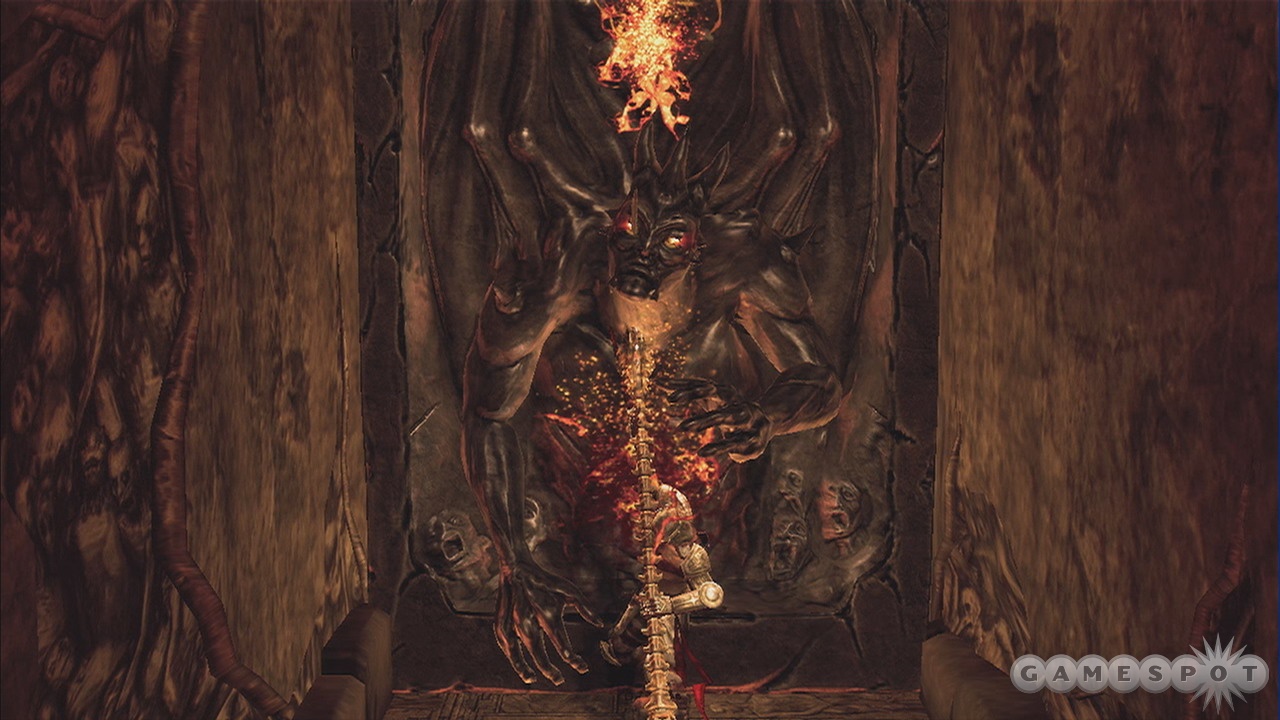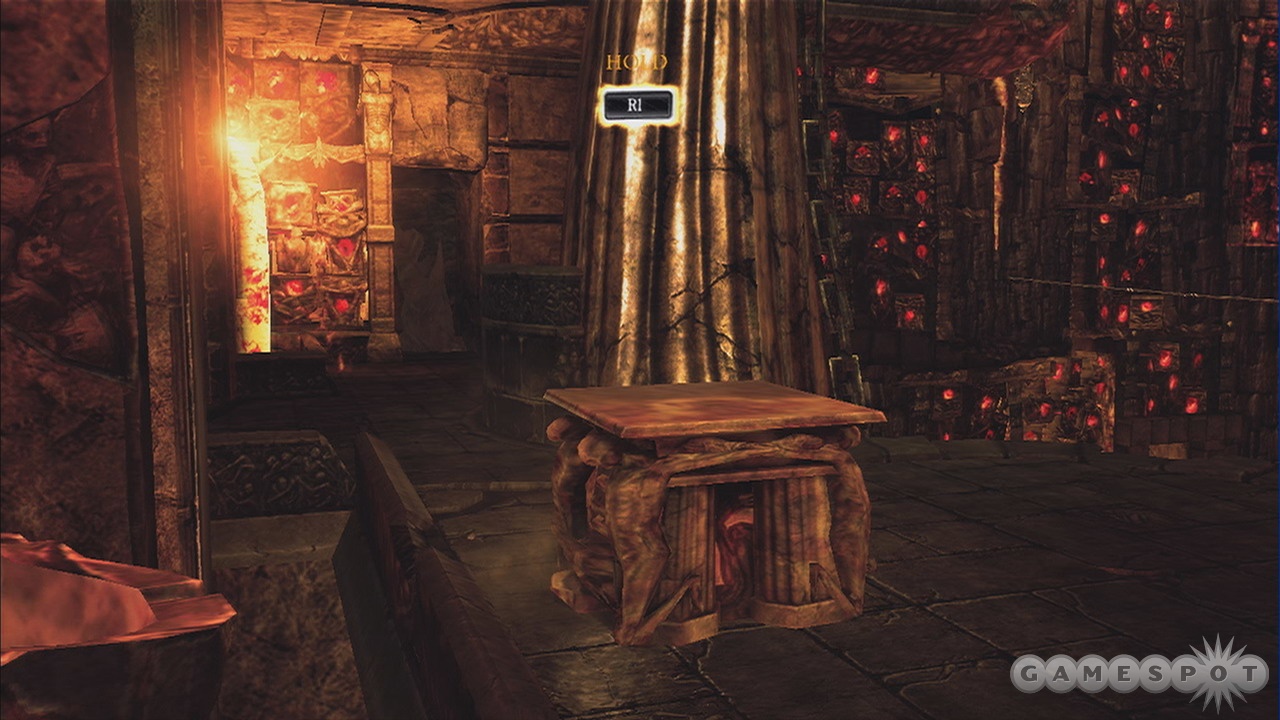While Dante slices through the belly of an undead beast with his razor-sharp scythe, traverses a crumbling bridge with a quick-time event, and overthrows the ruler of a damned land with vicious determination, a burst of familiarity might flash through your mind. From the gothic art style and the vengeance-fueled story to the stationary camera clearly displaying the blood-splattering combat, Dante's Inferno is a wholesale imitation of the superb God of War series. Or, at the very least, it's desperately trying to be. Unfortunately, the impression lasts for only the first few hours. What starts as a fast-paced and epic quest to destroy Lucifer in an underworld populated by grotesque and disfigured beings, devolves into a monotonous and downright predictable hack-and-slash. Dante's Inferno gets close enough to its source material to make for a gory and satisfying few hours in hell, but its many flaws prevent it from rising to paradise.
The lesson delivered by Dante's Inferno is one every person should keep in mind: Do not, under any circumstance, make a deal with the devil. You will lose, and you may not be handy enough with a scythe to hack your way out of the mess you create. In this case, Beatrice thought too highly of her husband Dante's moral character. Worried that he would lose his life while liberating heathens during his holy crusade, she comes to an agreement with Lucifer. If he stays faithful, the devil will ensure that he makes it home alive. If he loses control with a seductive slave girl, though, Beatrice will forfeit her own soul forever. The story is told using three distinct styles to chronicle Dante's descent into darkness to rescue the eternal spirit of his betrayed wife. The CGI and in-game cutscenes are expected, but it is the series of sparsely animated cartoons that stand out. These fill in the backstory of Dante's actions during the crusades and go a long way toward developing his character. The story has few surprises, but the manner in which it slowly puts Dante's entire life into perspective makes for an interesting setup for his adventure.
And the adventure does start out on a strong note. The first few hours have an epic scale that makes the descent from the earthly plain into the pits of hell feel like a momentous transition. Pathways crumble underfoot, threatening to spill you into the bubbling lava below; gargantuan creatures loom in the distance, tossing out taunts as you make you way through their defenses; and horrible abominations are introduced every few minutes. The vile enemies you battle are modeled on the circles of hell, and they do an impressive job of embodying these contemptible sins. Lust, for instance, is populated by prostitutes who were all too willing to sell their bodies while they were alive, and they are punished by having their souls sold in the afterlife. The typical anatomy of these women of ill repute is grossly exaggerated, and though you'll certainly want to avoid their disgusting makeshift lassos, their presence makes for a disturbing trip to the land of the damned.

In the early stages, you will battle a number of horrific caricatures. The prostitutes of lust are followed by obese monsters who do a fine (yet gross) job of personifying gluttony, and an army of blade babies who haven't been baptized are sure to get a rise out of even the most jaded individuals. But these disgusting portrayals of the deadly sins are soon forgotten as you get deeper into your quest. After the shocking imagery used in the early going, you have only knights and wizards to look forward to, which lack the appeal of the repulsive enemies that precede them. In fact, the only memorable foes in the entire game are introduced within the first couple of hours, making the rest of the adventure much less interesting and far more predictable. Furthermore, although it makes sense that the circle of gluttony would be populated by grossly obese individuals, the fact that they pop up in heresy, anger, and every other circle doesn't mesh with the rules set in place.
The level design follows a similar descent into banality. What starts as epic and explosive soon becomes repetitive. Too much of Dante's Inferno takes place in confined rooms that don't hint at the huge world you're in, which lowers much of the impact of clawing your way through the netherworld. The puzzles that crop up only serve to artificially slow your progress rather than give you a worthwhile change of pace from the violent combat. Much of the time, endurance is the only tool you will need to complete these tests. Box-dragging or crank-turning puzzles aren't fun or mind-bending challenges. Rather they are just time wasters and only detract from the experience. The few times that they do force you to think only reinforce the poor design of these puzzles. Difficulty only exists because the camera either doesn't show you what you need to see or highlights an area that is not important.
The bulk of the game focuses on Dante's expertise in eliminating forsaken souls, and the combat is the element that most closely mimics God of War. Battles are brutally violent. Your powerful scythe slashes through treacherous beasts like a hot knife through butter, and it's great fun to hack away at your enemy while you deftly roll away from its counterattacks. Quick-time events play a large part of the action, letting you take down your foes in elaborate and horrifically violent ways. The over-the-top, merciless portrayal of the combat fits in perfectly with the dark themes presented in the game, which makes it the strongest aspect of your quest. You earn souls for every enemy you kill, and these points go toward upgrading your attacks. There are both holy and unholy meters to fill, which let you personalize your moves a bit. Upgrading Dante gives you a steady stream of new attacks, and though you aren't able to unlock new weapons through the course of the game, there is enough variety to make sure combat doesn't get stale.
But the combat is not without a few flaws, which results in more than a few aggravating moments. First of all, once you begin a combo, you must see it through to the end, which is maddening if you're trying to avoid an attack but Dante is stubbornly still swinging away. Second, you have a handy projectile attack, but the auto-aim functionality doesn't work right, so it's nearly impossible to hit a specific enemy in a crowded room. Third, challenge is all over the place. Most fights are fairly easy, but knockback attacks are overpowered. All too often, Dante will be caught in a chain of punishment that is impossible to break out of because enemies can attack you even when you're lying prone on the ground. It's possible to lose half of your life bar or more to these annoying situations, which makes the otherwise fun fights quite frustrating.
The quality of Dante's Inferno fluctuates wildly throughout the course of the game. During the first one-third of this eight-hour adventure, the diverse array of enemies and epic environments make for an enjoyable, hectic quest for vengeance. Things level out in the middle one-third, though. Memorable characters are no longer introduced and the level design is far less adventurous, but the frantic combat is enough to make this stretch fun, if not particularly noteworthy. The final one-third of this game is uninspired and downright bad at times, making for a wholly unsatisfying end to this derivative game. During the buildup to the end boss, level design has been virtually scrapped. Instead of tearing through the depths of hell, you are confined to a series of platforms where you must pass certain objectives before you can move forward. For instance, you will need to eliminate every enemy without summoning magic or by just using air attacks, which is just as lifeless as it sounds. This is a boring way to end the game and leaves a sour taste when the credits roll.
It's a shame the entirety of Dante's Inferno couldn't match the frenetic pacing and horrific imagination found in the beginning of your adventure because it could have been a worthwhile alternative to the excellent God of War series. But most of the game falls far short of its impressive beginning, which results in a repetitive and uninspired adventure that loses steam long before you reach the bitter end. Dante's Inferno is certainly fun during those hectic first few hours, but there is little reason to play beyond those parts. It's not worth visiting hell without the promise of heaven on the other side.
